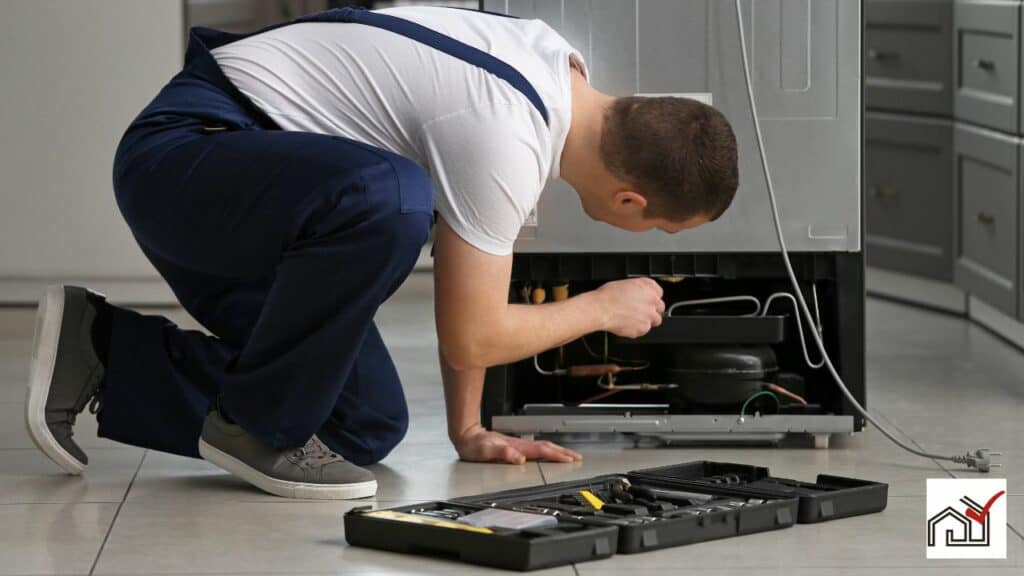If your GE Profile refrigerator is not cooling, check the following potential issues:
- Verify that the temperature settings are correct.
- Inspect the evaporator coils for any malfunctions, as they are crucial for cooling.
- Ensure the door seals are intact to keep out warm air.
- Clean any clogged condenser coils, which can affect the refrigerator's efficiency.
- Check if the cooling fan is working properly to maintain airflow.
If these steps do not resolve the issue, consider consulting a professional technician to repair the refrigerator.
Incorrect Temperature Settings
A GE Profile refrigerator not cooling properly is often due to incorrect temperature settings. To fix this, refer to the owner's manual for the recommended temperature settings for your model. Use a separate thermometer to check the actual temperatures in the refrigerator and freezer. If temperatures are too high, lower the settings incrementally and wait 24 hours for the fridge to adjust. Aim for a refrigerator temperature below 40°F for safe food storage.
Check that the fan and air vents are not blocked, as this affects air circulation. Test the fan manually for any resistance. If the fan blade doesn't move smoothly, it may need to be repaired or replaced.
Proper temperature settings and functional fans and vents should resolve most cooling problems with GE Profile refrigerators.
Malfunctioning Evaporator Coils
If a GE Profile refrigerator is not cooling properly, it may be due to issues with the evaporator coils. These coils are essential for absorbing heat from the fridge's interior and help maintain the desired temperature.
The evaporator fan motor aids in this by drawing air over the coils and circulating it throughout the fridge and freezer. If this motor fails, the refrigerator will not cool efficiently, possibly leading to food spoilage.
To check the evaporator fan motor, look for any blockages around the fan blade and listen for abnormal sounds from the motor. A continuity test with a multimeter can confirm if the motor needs replacing.
It's important to fix a defective fan motor quickly to ensure the refrigerator cools as intended.
Faulty Door Seals
A damaged door seal can reduce the cooling efficiency of a GE Profile refrigerator. The seal is essential for keeping the interior airtight and ensuring stable temperatures. If the seal is twisted, torn, or damaged, it can allow cold air to escape, making the refrigerator work harder and potentially reducing its lifespan.
To troubleshoot cooling issues, examine the door seal for wear or damage, such as cracks or tears, and check for dirt or debris that could prevent a secure closure.
A wet cloth can clean the seal, but if problems continue, a replacement gasket may be necessary. Replacement seals for specific models are available to maintain optimal cooling.
To test the seal, place a piece of paper between the door and the refrigerator. If the paper slides out easily, the seal might not be secure, indicating why the refrigerator is not cooling efficiently. Addressing faulty door seals quickly is important to preserve the refrigerator's performance.
Clogged Condenser Coils
Check the door seals for any gaps or damage. If they are in good condition, inspect the refrigerator's condenser coils for clogs, as this can affect cooling performance. The condenser coils release heat and can accumulate dust and debris over time, which insulates them and reduces their efficiency.
For optimal refrigerator function, keep the condenser coils clear. Clean them every six months. Refer to the owner's manual for your GE Profile refrigerator to find the coils' location. Use a vacuum and a brush to clean them carefully.
Also, examine the condenser fan motor, which pulls air through the coils. If the refrigerator isn't cooling well and the coils are clean, the fan motor may be defective. Test the motor with a multimeter to check for continuity. If there's no continuity or the motor doesn't run, consider replacing it. A working condenser fan is vital for heat removal and efficient cooling.
If the condenser fan motor fails the tests, replacing it may be necessary to regain full cooling efficiency in your refrigerator.
Defective Cooling Fan
A defective cooling fan can prevent a GE Profile refrigerator from maintaining the correct temperature. The cooling system requires two essential components: the evaporator fan motor and the condenser fan motor, both of which are integral to the refrigeration cycle. Malfunction in either can reduce cooling efficiency.
The evaporator fan motor circulates air in the fridge and freezer. If it fails, the refrigerator compartment won't cool effectively. Check if the fan blade moves freely and use a multimeter to test the motor's continuity. If the fan blade is stuck or the motor has no continuity, replace the fan motor.
The condenser fan motor moves air through the condenser coils and the compressor. If this fan fails, the compressor may overheat, affecting cooling. Check for obstructions and test if the fan blade and motor have continuity. If there's an issue, replace the condenser fan motor.
To troubleshoot a non-cooling GE Profile refrigerator, examine both fan motors for malfunctions, testing for continuity and unobstructed movement. Replace defective motors quickly to restore proper cooling.





